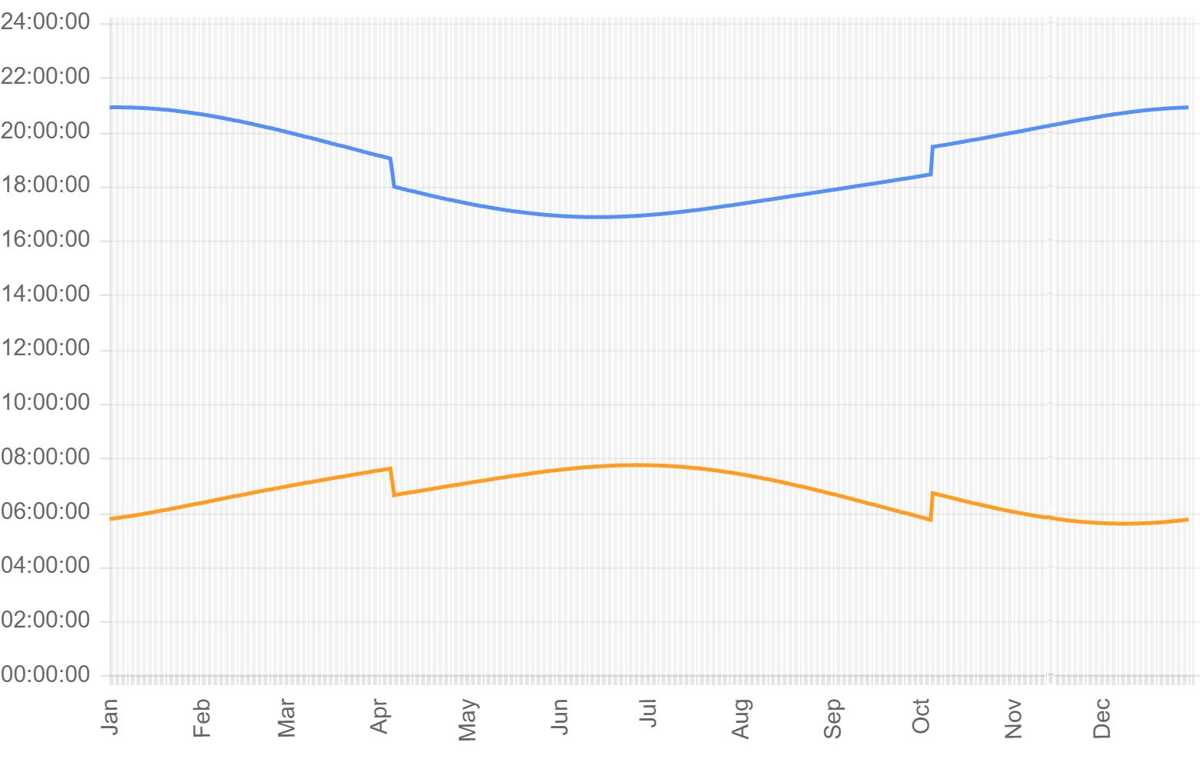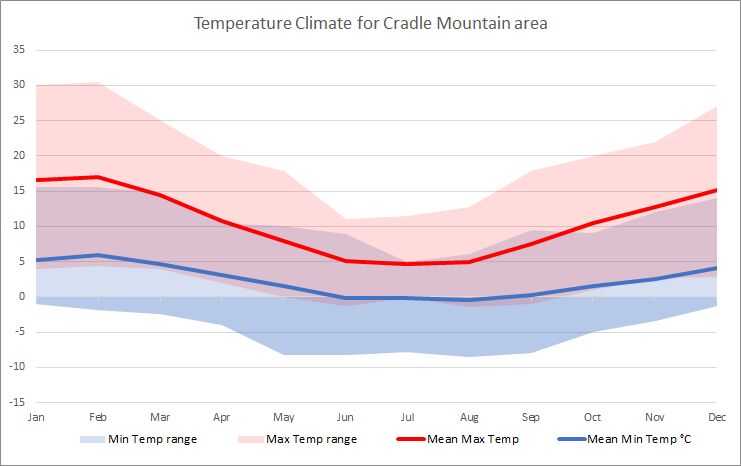There is no doubt that December, January and February are the most popular time to walk the Overland Track, and for good reasons. Of course, the most popular time is not the best time for everyone; it depends on your level of experience and motivation for walking the track.
So let’s explore different times of the year and look at the conditions. We can also explore the time of day and other considerations around timing.

Don’t feel the need to rush and just get the track ‘done’. The preparation for the journey can add to the whole experience. Give yourself enough time to build your fitness, prepare your meals, test out your gear and get experience walking in different conditions.
If you have not done many overnight walks before, give yourself time to get out and walk, test out your pack, boots and other gear. If you are not an experienced walker, you will probably want 6 months to build up the fitness, equipment and experience.
You will also need to think through saving the money you will need for the track, gear, supplies, travel and accommodation. There are other boring practical things like working out holiday leave and when your friends are keen to walk.
I tend to have pretty lazy trips and start walking around 9 am most days (earlier on the first day). This will vary a bit depending on the weather forecast. You can go with the flow as I do, but I know some people plan their walking time on track to coincide with sunrise and to maximise time for side trips.
It can be a real joy to pack up and start walking just before sunrise, to have breakfast partway down the track with open vistas and to have the track all to yourself. This gives you more time to enjoy side trips and greater capacity to reach the next campsite if things don’t go to plan. In clear weather, it can be nice to get up hours before sunrise and walk with a headtorch through twilight - even more special with a full moon.
With an early start comes great responsibility. If you are planning an early start, then try hard not to wake up your fellow walkers. If camping in a tent, this is much easier as the tent platforms are spread out a bit. In the hut, take time to organise your gear well and then pack up away from the sleeping platforms. Let your fellow walkers know about your early morning plans - people are much more understanding when they know what's going on.
Daylight saving in Tasmania starts at 2 am on the first Sunday in October, turn clocks back one hour. It ends at 3 am daylight saving time (2 am standard time) on the first Sunday in April the following year, (turn clocks back one hour).

Different times of year are represented by very different climates on the Overland Track. Now, climate and weather are two different but related things. Climate is the average or typical weather for a region over time. For example, we know that summer is warmer than winter. It is important to remember that climates are trends and typical, but there will be massive variations of weather during the seasons. So in Summer, even though the mean (average) daily maximum temperature is 16.6°C in January, that temperature usually ranges between 11-22°C. Historically the extremes of the maximum daily temperature have been 4°C & 30°C. This variation is also true with all other weather factors such as total rainfall, number of rainy days, UV index, humidity, wind speeds and so on.
Records are set to be broken later. The daily extremes (such as a maximum temperature of 30°C) will change in the future. These are helpful guides to give you a sense of what to expect, but next time these records are broken someone will be on track. With climate change, we know the average temperature is rising, but be aware that all this extra energy in the atmosphere powers more extreme weather, so as the earth warms we need to be ready to experience hot weather as well as more extreme colder weather.

Summer is the most popular time to walk with Overland Track with the bulk of people walking the track during these months.
Summer is unique because:
- Longest daylight hours
- Normally the warmest time of year (means max daily temp 15-17°C)
- Rarely dipping below 0°C
- The driest time of year, especially February (average total monthly rainfall 180,150,120mm)
- Many wildflowers are in bloom
- Many people on track, huts often at capacity
- Fee-based booking system in place, book early - you must walk in the direction from Cradle to Lake St Clair - it can be hard to book a specific departure date.
A magical time to walk, the are fewer people on track, March tends to still be summer-like weather. School & public holidays it can get busy (mainly Anzac Day time). This is a great time to see the unique deciduous beech trees that Tasmania is famous for.
Autumn is unique because:
- Temperatures and weather vary greatly (means max daily temp 14, 11, 8°C)
- Starting to get more rain, May can be much wetter (average total monthly rainfalls 148, 204, 276mm)
- Significant snow generally starts settling around May
- The yellow and red change of the deciduous beech trees
- A wider variety of colourful fungi
- Other than public holidays the number of people on track is lower than in summer
- Fee based booking system in place, book early - you must walk in the direction from Cradle to Lake St Clair
- Need to be prepared for walking in significant snow
The Overland Track is a winter wonderland for those experienced, skilled and equipped for walking in snow and extreme cold conditions. There is no guarantee of deep snow, the amount of snow varies a lot from year to year and through the months. It is a wonderful time to walk if you are capable of walking in such extreme conditions. Do not underestimate how hard this track can be. On one trip in winter, I only saw one other person in the 10 days of the walk. There are far fewer people on track for a good reason.
Winter is unique because:
- Temperatures and weather varies greatly (means max daily temperatures are around 5°C)
- It is consistently really wet, the wettest season (average total monthly rainfalls 272, 316, 302mm)
- It is muddy - really deep mud
- Be prepared to use snowshoes and navigate when the track is not visible for a significant part of the trip. Especially at the northern end
- Very few people on the track, you may have the huts to yourself
- A sunny day on track is extra clear and stunning
- Walking the steeper sections and doing side trips can be particularly hazardous in the wet and icy conditions. Micro-spikes are highly recommended to improve traction.
- There is free booking system in place, helping reduce the track being overwhelmed on any specific day. You can walk in any direction. Since the Cradle Mountain end is exposed to the coldest conditions and usually the most snow/ice, it can be an extra challenging segment of the walk. Some people prefer to wait for clear conditions and get through this section with a clear forecast. Starting from the south may mean you need to wait for a weather window at Waterfall Valley. However, some people prefer to start at the southern end if there is significant snowy weather when starting, to have less severe conditions, in the hope the conditions improve by the time they approach the northern end.
- Always be prepared with extra supplies in case you need to wait for conditions to improve while on track
- Ensure your tent and sleep system is 4-season rated for snow and sub-zero temperatures
Spring is when you can be sure the wind will be blowing. There is likely to be plenty of snow and rain. There are still not a lot of people on track, although by November the conditions tend to be more favourable for walking and more people start to walk the track. You still need to be prepared for significant snow coverage even in November.
Spring is unique because:
- Temperatures and weather vary greatly (average max daily temperatures are 7.5, 10.5, 13°C)
- It is consistently wet (average total monthly rainfalls 270,252, 205mm)
- It is still really muddy
- Be prepared to use snowshoes and navigate when the track is not visible for a significant part of the trip. Especially at the northern end.
- Not a lot of people on track in September, but building up over in November to be nearly as busy as summertime
- Walking the steeper section and doing side trips can be particularly hazardous in the wet and icy conditions. Micro-spikes are highly recommended to improve traction.
- There is free booking system in place for September, helping reduce the track being overwhelmed on any specific day - you have more flexibility and can walk in either direction
- Fee-based booking system in effect from 1st October. There are usually October start dates available until even a few weeks prior (if you are flexible by a few days). You must walk from North to South. It is far more likely you will experience extreme weather conditions and bushwalk warnings this time of year than in summer. You are more likely to need to adjust your booked starting time due the weather conditions.
- Always be prepared with extra supplies in case you need to wait for conditions to improve while on track
- Ensure your tent and sleep system is 4-season rated for snow and sub-zero temperatures